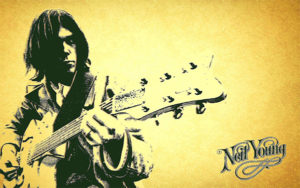
Why fitting in might mean missing out
05.24.19
A few years ago, when I was first learning to play guitar, I had a go-to song that made me feel I was half-decent… even though I really wasn’t.
It was Horse With No Name by America – and I liked it because it was a breeze to play.
I found a beginner’s arrangement with two simple chords that required moving one finger in the whole song, with a basic strumming pattern. A chimp could play Horse With No Name, it’s that easy.
I also tried to sing like America. It made me feel like I fit in, like I was a player. l was delusional, of course. I was trying to be someone else, not me. And I wasn’t very good at it.
As it turns out, America may have been trying to fit in too. The view for years – never verified, often speculated – was that Horse With No Name was America’s way of trying to sound like Neil Young. It was 1971. Young had already made his mark with Buffalo Springfield and Crosby, Stills Nash & Young. He was now solo and recording songs like Old Man, Heart of Gold and The Needle and the Damage Done. He and his distinctive voice didn’t fit in. They stood out.
Intentional or otherwise, America’s strategy worked, if only briefly. Horse With No Name went to #1, and many really thought it was Neil. America went on to have a decent career with a handful of songs that performed well on the charts. But they faded away by the late ‘70s. As the kids say, meh, whatever.
Yet here we are now, nearly 50 years later, and Neil Young is still rocking. He’s in the Rock and Roll Hall of Fame (twice). His sound isn’t for everyone, but make no mistake… it’s distinctively his. It made him a lot of money and garnered him a lot of success.
And he did it by being his own unique self.
So, is this the difference between good and great? Is this the contrast of trying too hard to fit in and doing your best to stand out?
Put yourself in the arena
I recently watched The Call to Courage, a Netflix documentary featuring leadership guru and author Brene Brown. A good part of her presentation was about vulnerability – what she calls “putting yourself in the arena.” It means being brave enough to be your true self, to show who you really are and what you stand for. Inherent in all of this is taking risks, being vulnerable to failure and, every so often, “getting your butt kicked.”
And then she said something that stopped me in my tracks.
The opposite of belonging, she said, isn’t “excluding,” which is what we’ve been led to believe since we were kids at the playground. Instead, Brown suggests the opposite of belonging is actually fitting in. When we try to conform, to seek the approval of others by being like them… that’s not belonging. It’s acting. When we belong, there’s no need to act.
The world is full of inspirational examples of not fitting in:
- There are the legit game-changers like Mandela and Gandhi. Conformists? I don’t think so.
- Bob Dylan didn’t fit in by going electric at the Newport Folk Festival. He took a risk by being his true self.
- If Jeff Bezos wanted to fit in, he’d have bought real estate and built big box stores, like Indigo and Barnes & Noble.
Each created their own sense of belonging – on a massive scale – by being themselves. In the arena.
So, what about you and me? What if we spent more time being ourselves and less time trying to fit in?
By being proud of who we are.
By being clear on what we stand for… and believe… and do.
By finding (and using) our own distinctive voice.
You have that voice. I know you do. So, let’s hear it.
Belonging is when we put ourselves in the arena, and we’re accepted for who we really are. Not acting.
As Oscar Wilde said, “Be yourself. Everyone else is already taken.”
Ask yourself:
- Are you trying to fit in?
- Or are you putting yourself in the arena?
- If not, what are you waiting for?
~ Craig

